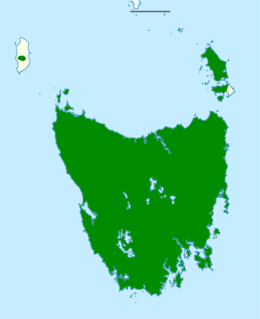| Green rosella | |
|---|---|

| |
| Scientific classification | |
| Domain: | Eukaryota |
| Kingdom: | Animalia |
| Phylum: | Chordata |
| Class: | Aves |
| Order: | Psittaciformes |
| Family: | Psittaculidae |
| Genus: | Platycercus |
| Species: | P. caledonicus
|
| Binomial name | |
| Platycercus caledonicus (Gmelin, 1788)
| |

| |
| Range (in green) in Tasmania | |
| Synonyms | |
The green rosella or Tasmanian rosella (Platycercus caledonicus) is a species of parrot native to Tasmania and Bass Strait islands. It was described by the German naturalist Johann Friedrich Gmelin in 1788, and named on the mistaken assumption it came from New Caledonia. At 14.5 in (37 cm) long it is the largest species of the rosella genus, Platycercus. Two subspecies are recognised. The green rosella's underparts, neck and head are yellow, with a red band above the beak and violet-blue cheeks. The back is mostly black and green, and its long tail blue and green. The sexes have similar plumage, except the female has duller yellow plumage and more prominent red markings, as well as a smaller beak. Juvenile and immature birds have predominantly green plumage.
Found in a wide range of habitats with some form of tree cover, the green rosella is predominantly herbivorous, consuming seeds, berries, nuts and fruit, as well as flowers, but may also eat insect larvae and insects such as psyllids. Nesting takes place in tree hollows. Common and widespread across Tasmania, the green rosella is rated as least concern on the International Union for Conservation of Nature (IUCN)'s Red List of Endangered species. The King Island subspecies has been classed as vulnerable as its population has declined after much of its habitat on King Island was cleared.
- ^ "Platycercus caledonicus". IUCN Red List of Threatened Species. 2016. BirdLife International: e.T22685104A93058976. 2016. Archived from the original on 5 December 2020. Retrieved 2 July 2021.
